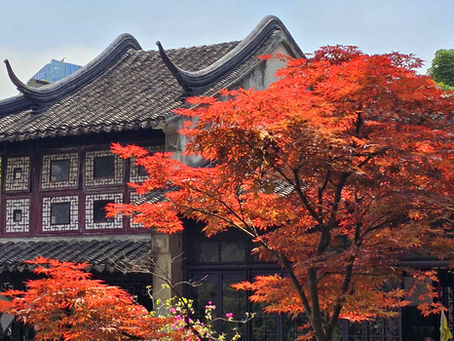top of page

GLOBAL SHANANIGANS

Search


Sacred Tombs of The Pagoda Forest
Located at the base of Mount Shaoshi in Henan Province, the Pagoda Forest at Shaolin Temple is a sacred necropolis within the broader monastery complex. With its origins tracing back to 618 AD during the Tang Dynasty, the forest is home to over 240 stone and brick pagodas, each serving as a tomb or memorial for esteemed monks, abbots and martial art masters.
Shannon


Kuanxiangzi Alley & The Blood Lantern Widow
Tucked into the vibrant heart of Chengdu, the capital of Sichuan Province, Kuanxiangzi Alley is a rare remnant of Qing Dynasty urban design, its origins reaching back over 300 years. Established in the late 17th century, the alley was constructed over an ancient military garrison and gradually developed into an elite residential area.
Shannon


Meijiawu Tea Village - Tea of the Emperors
Tucked into the misty hills near Hangzhou’s famous West Lake, Meijiawu is more than just a tea village, it’s a living testament to China’s centuries old relationship with tea. The name "Meijiawu" translates to "The Village of the Mei Family," pointing to a 600-year lineage of hand cultivating tea that began with the Mei clan and continues to thrive today. Over time, this small village grew into a national symbol, with its identity and prosperity deeply intertwined with tea cu
Shannon


Bailong Elevator - In the Shadow of Dragons
Rising like a gleaming spine along the raw sandstone cliffs of Zhangjiajie National Forest Park in China’s Hunan Province, the Bailong Elevator, also known as the "Hundred Dragons Elevator" is both a marvel of modern engineering and a looming monolith that stirs ancient fears. Piercing 326 metres into the sky, it is the tallest outdoor elevator in the world.
Shannon


Yangshuo County - A Journey Through History and Hills
Tucked deep within Guangxi’s dramatic karst terrain, Yangshuo's landscape is far more than a picturesque backdrop, it is steeped in spiritual and supernatural significance. For centuries, locals have believed the towering limestone peaks to be the resting places of ancient spirits, with many formations given mythological names and stories. One of the most iconic is Moon Hill, named for its crescent shaped cave, which legend says was created by a celestial blade slicing throug
Shannon


The Lingering Garden
In a city celebrated for its canals, silk and scholars, Suzhou’s Lingering Garden represents a pinnacle of classical Chinese garden design. Often referred to as one of the “Four Great Classical Gardens of China,” it embodies centuries of artistic refinement and philosophical thought. Built in 1593 during the Ming dynasty by Xu Taishi, a high-ranking official who sought retirement and tranquility, the garden stands as a personal reflection of his scholarly ideals.
Shannon


Seven Star Park of the Immortals
Seven Star Park, located on the eastern side of Guilin, Guangxi, derives its name from the formation of seven limestone peaks arranged in the shape of the Big Dipper constellation. This celestial reference is not only a poetic nod to the stars but also deeply symbolic in Chinese cosmology, where the Big Dipper is associated with divine guidance, fate and protection.
Shannon


Empire of Blood - The Violent Rise of Shanghai
Shanghai’s origins date back over a thousand years but its transformation from a modest fishing village to one of the world’s largest metropolises is marked by turmoil and bloodshed. The area was initially a small settlement under the Song dynasty between 960 - 1279AD, primarily a fishing and textile hub.
Shannon


Yu Garden - The Heart of Old Shanghai
Located in Shanghai's historic Old City near the City God Temple, Yu Garden is one of the best preserved examples of classical Chinese garden design. It was originally constructed in 1559 during the Ming Dynasty by Pan Yunduan, a high ranking imperial officer. Pan built the garden as a retirement retreat for his aging father, Pan En, intending it to be a place of comfort and tranquility. The name Yu itself means peace and contentment, symbolising his filial piety.
Shannon


Jingjiang Princes’ Palace
The Jingjiang Princes’ Palace, constructed in 1372 during the early Ming Dynasty, served as the residence of Zhu Shouqian, a nephew of the dynasty’s founding Emperor Zhu Yuanzhang. Perched at the foot of Duxiu Hill in Guilin, the palace was more than just a lavish estate, it embodied the Ming strategy of installing Vassal Kings across the Empire to maintain dynastic stability and guard the frontiers.
Shannon


The Dark Reign of Jiajing - Death by a Thousand Cuts
The Jiajing Emperor, who ruled China’s Ming Dynasty from 1521 to 1567, is often remembered for his sadistic and tyrannical reign marked by cruelty, decadence and obsession with immortality. His relentless pursuit of eternal life led him to engage in dark and brutal practices, one of the most notorious being his bloodlust for a substance called “red lead.” This concoction was allegedly made using the menstrual blood of young virgin girls.
Shannon


Yaoshan Mountain - The Roof of Guilin
Yaoshan Mountain scenic area, standing at 909 metres, received its name in 221 BC with the construction of the Yao Emperor Temple at its summit. As the tallest peak in the Guilin region, it offers breathtaking panoramic views of the surrounding karst landscape, limestone formations that define the area’s iconic scenery. This early naming coincided with the unification of China under the Qin Dynasty, marking Yaoshan as a site of both natural prominence and emerging cultural si
Shannon


Zhangjiajie Glass Bridge
When the Zhangjiajie Glass Footbridge opened to the public in August 2016, it instantly shattered world records as the highest and longest glass bottomed suspension bridge. Stretching 430 metres across and suspended 300 metres above the Zhangjiajie Grand Canyon, it connects the dramatic cliffs of Yuanjiajie and Tianzi Mountains, terrain said to have inspired the floating mountains in Avatar.
Shannon


The Leshan Buddha - Guardian of the Rivers
In the heart of Sichuan Province, nestled at the confluence of the Min, Dadu and Qingyi Rivers, the Leshan Giant Buddha looms as one of China’s most awe inspiring historical landmarks. Towering at 71 metres high, this colossal statue is the largest stone Buddha in the world and remains a profound testament to ancient Chinese ingenuity and spiritual devotion.
Shannon


Tianmen Mountain - Heavens Gate
Often hailed as the “Gateway to Heaven,” Tianmen Mountain stands as one of China’s most breathtaking natural marvels. Perched above the city of Zhangjiajie in Hunan Province, this majestic peak rises to 4,980 feet above sea level. From its lofty heights, visitors are rewarded with sweeping panoramic views of rolling valleys, jagged cliffs and pristine forests that have remained untouched for centuries.
Shannon


The Vassal Kings - Inside the Jingjiang Tomb Complex
Located at the western foot of Yaoshan Mountain, the Jingjiang King Tombs Complex spans over 100 square km's and serves as the final resting place of the Ming Dynasty royal family, who ruled China from 1368 to 1644. This vast and historically rich burial site offers a glimpse into the grandeur and legacy of one of China’s most powerful dynasties, with its sprawling layout and deep cultural significance reflecting the status and influence of the royals interred here.
Shannon


Behind the Crimson Walls - Secrets of The Forbidden City
The enormous Imperial Palace complex, commissioned by the Yongle Emperor of the Ming Dynasty in 1406AD, is the world largest palace and contains the most extensive amount of preserved wooden structures on the planet. Located in the heart of Peking, one of the great ancient capitals of China, the Forbidden City was built to legitimise Yongle's supreme authority (after he usurped the throne) and to assert the power and grandeur of the new capital Beijing, as a stronghold to thr
Shannon


The Great Wall of China - A History Carved in Blood and Stone
Stretching over 21,000 kilometres across rugged mountains, arid deserts and sweeping valleys, the Great Wall of China stands as one of the most iconic and enduring structures in human history. Built, rebuilt and expanded over many centuries by a succession of Chinese dynasties, this colossal fortification was designed to safeguard the Chinese empire from invading forces, particularly the nomadic tribes from the northern steppes, including the Mongols.
Shannon


Shaolin Monastery - The Birthplace of Kung Fu
The Shaolin Monastery was founded in 495AD during the Northern Wei Dynasty by Emperor Xiaowen to accommodate an Indian monk named Batuo. But it wasn’t until a second Indian monk, Bodhidharma arrived around 527AD that the legends really began. Bodhidharma, considered the father of Zen Buddhism, is said to have meditated in a cave near the temple for nine years, facing a wall until he achieved enlightenment.
Shannon


Suzhou - Whispers on the Water
Set in the heart of Jiangsu Province, Suzhou is often called the “Venice of the East”, a poetic nickname but one that barely scratches the surface. Suzhou is more than romantic, it’s resilient. Its story spans dynastic splendour, foreign intrusion, civil war and a remarkable cultural revival. Founded over 2500 years ago during the historical Spring and Autumn Period, the city was once known as Wu.
Shannon
bottom of page